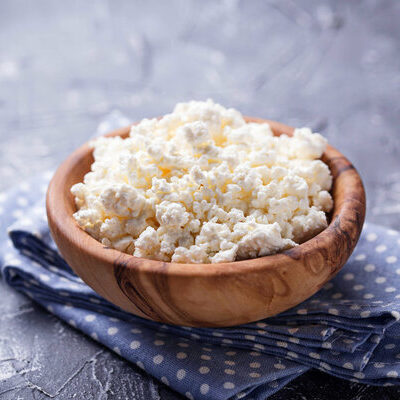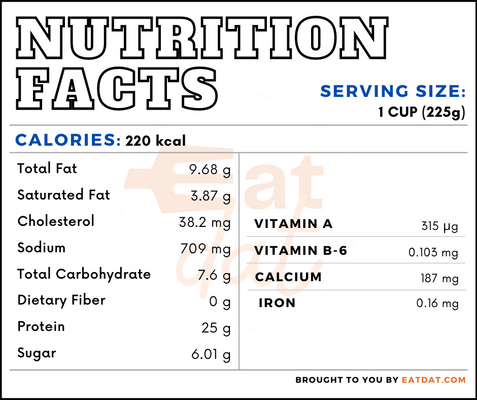
Cottage Cheese
also known as Dutch cheese, Schmierkase
What is Cottage Cheese?
Cottage cheese is a dairy product that is made from cow’s milk. The name of the cheese comes from the fact that cheese was originally made in country homes and consumed fresh.
- There are different types of cottage cheese, but it is always a fresh cheese and is never aged.
- This dairy product is usually white, cream, or yellow in color and has a soft and crumbly texture and a slightly sour flavor.
Some varieties can also be creamy. It is a common diet food and is popular as a protein source among vegetarians. Cottage cheese may be eaten alone, with fruits or vegetables or used in baking.
Some popular cottage cheese brands include:
- Good Culture
- Daisy
- 365 Whole Foods
- Cabot Creamery
- Breakstone’s
- Horizon Organic
- Kalona Supernatural
- Market Pantry
- Muuna
- Nancy’s
- Organic Valley
- Trader Joe’s
Origin of cottage cheese
Cheese production goes back to more than 4,000 years ago. One of the more enduring legends attribute it to an accidental discovery. An Arab trader was traveling and kept some milk in sheepskin. The heat and the rennet in the skin converted the milk into cheese. The earliest records are from Ancient Egyptian murals, where this process is depicted.
From Asia, this dairy product traveled to Europe, where it became extremely popular in the Roman Empire. It spread throughout Europe and later introduced into the Americas by European colonizers. However, cottage cheese is special as far as dairy products go since it does not require rennet, as it curdles with Mesophilic lactic acid bacteria. Cottage cheese can be produced by simply setting milk by a fire and allowing the bacteria to do its work.
Nutrition
Nutritional profile for cottage cheese (1 cup, small curds):

Cottage cheese is rich in calcium, phosphorous, potassium, sodium, and vitamin A. Also, it contains magnesium, selenium, fluoride, folate, choline, retinol, carotene, and vitamin D in decent quantities. Regular consumption of cheese may help in combating inflammation, preventing osteoporosis and arthritis, decreasing the risk of fractures, and managing obesity. People with lactose intolerance may also eat cheese without problems. Also, it can be useful in preventing diabetes, cardiovascular disease, and cancer.
Commercial production
The largest cheese producing countries are the USA, Germany, France, Italy, the Netherlands, Poland, Russia, Egypt, Czech Republic, Argentina, and the UK.
Cheese is produced from milk with the help of coagulants. Traditionally, this used to be rennin, but other acids are nowadays also used. Other flavorings such as herbs, spices, and salt may be added to the product to enhance flavor.
First, the milk is processed and then the rennin or other enzymes are added to it, allowing it to ferment and curdle. Then, the curds and whey begin separating and the curds are cut once they form a whole mass. Once cut, the mas is stirred and cooked further until the whey is completely separated, after which it is drained away. After that, the curds are chilled to prepare the cheese. Cream may be added at the end.
Cottage cheese recipes
This cheese is an extremely versatile food. It may be fried and served with spice, used as a dip, made into sweets and desserts, and used in preparing baked goods and a variety of other dishes. Here are a few recipes to try:
- Buns
- Spinach Soup
- Paneer Bhurji
- Shahi Paneer
- Baked Ziti
- Flan
- Baked Eggs with Chimichurri Sauce
- Gzik
- Túrós Csusza
- Papanasi
- Jajik
- Kunafa
- Spanakopita
FDA regulations
Cottage cheese is defined as the soft uncured cheese prepared by mixing cottage cheese dry curd with a creaming mixture, and containing at least 4 percent milkfat and at most 80 percent moisture.
References
Monika B., How to Make Cottage Cheese? | Industrial Microbiology, Biology Discussion, https://www.biologydiscussion.com/industrial-microbiology-2/cottage-cheese/how-to-make-cottage-cheese-industrial-microbiology/86700
Thorning, Tanja Kongerslev et al. “Milk and dairy products: good or bad for human health? An assessment of the totality of scientific evidence.” Food & nutrition research vol. 60 32527. 22 Nov. 2016, doi:10.3402/fnr.v60.32527, https://www.ncbi.nlm.nih.gov/pmc/articles/PMC5122229/
Dekker, Louise H et al. “Cheese and Healthy Diet: Associations With Incident Cardio-Metabolic Diseases and All-Cause Mortality in the General Population.” Frontiers in nutrition vol. 6 185. 17 Dec. 2019, doi:10.3389/fnut.2019.00185, https://www.ncbi.nlm.nih.gov/pmc/articles/PMC6927928/
Rozenberg, Serge et al. “Effects of Dairy Products Consumption on Health: Benefits and Beliefs–A Commentary from the Belgian Bone Club and the European Society for Clinical and Economic Aspects of Osteoporosis, Osteoarthritis and Musculoskeletal Diseases.” Calcified tissue international vol. 98,1 (2016): 1-17. doi:10.1007/s00223-015-0062-x, https://www.ncbi.nlm.nih.gov/pmc/articles/PMC4703621/
